To deal with the multitude of different fire classes, a range of fire extinguishers have been developed. Please click on the type of extinguisher, this will display more information about that extinguisher type.
Water Extinguisher
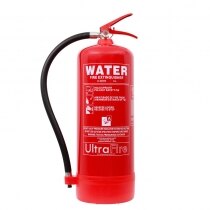 |
Signal Red |
| Best For |
| Fires involving organic solid materials such as wood, cloth, paper, plastics, coal etc. |
| Danger |
| Do not use on burning fat or oil or on electrical appliances. |
| How to Use |
| Point the jet at the base of the flames and keep it moving across the area of the fire. Ensure that all areas of the fire are out. |
| How it Works |
| Water has a great cooling effect on the fuel’s surface and thereby reduces the pyrolysis rate of the fuel. |
Water Spray Extinguisher
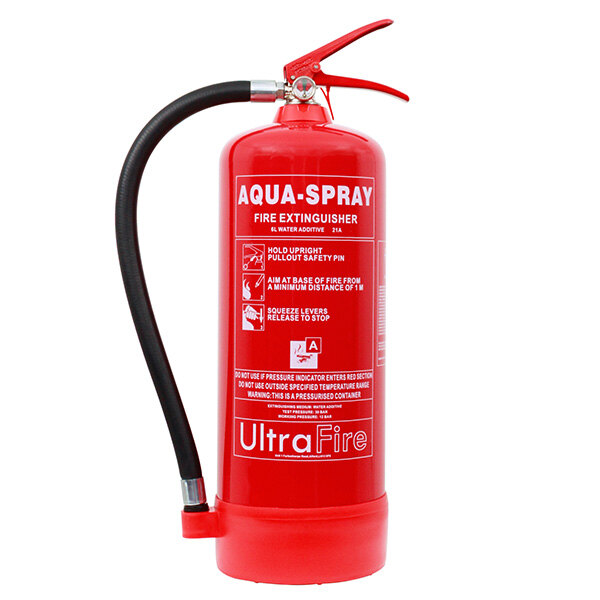 |
Signal Red |
| Best For |
| Fires involving organic solid materials such as wood, cloth, paper, plastics, coal etc. These offer significantly improved fire fighting capability compared to traditional jet type water fire extinguishers. Available in 3 and 6 litres. |
| Danger |
| Do not use on burning fat or oil or on electrical appliances. |
| How to Use |
| Point the jet at the base of the flames and keep it moving across the area of the fire. Ensure that all areas of the fire are out. |
| How it Works |
| Water has a great cooling effect on the fuel’s surface and thereby reduces the pyrolysis rate of the fuel. Instead of a jet nozzle a spray nozzle is used, with a higher pressure, which creates a fine spray. This allows for a given quantity of water to have a considerable increase in the surface area presented to the fire. This makes extinguishing more efficient by more rapid extraction of heat, formation of steam etc. |
Water Mist Extinguisher (De-Ionised Water)
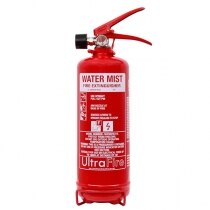 |
Signal Red on a White Background |
| Best For |
| The first broad spectrum extinguisher to tackle A, B, C rated risks as well as small amounts of burning fats . Models filled with de-ionised water and tested with dielectric test to 35k Volts can be safely used on electrical fires (up to 1000 Volt) if a safety distance of 1m is adhered to, as their mist (de-ionised water) does not conduct electricity and the extinguisher does not normally form puddles, which could conduct electricity. The UltraFire water mist extinguishers contain only de-ionised water which cannot carry any electric current. |
| Danger |
| Do not use on deep fat fires or Grade D (burning metal swarf) fires. |
| How to Use |
| Point the nozzle at the base of the flames and keep it moving across the area of the fire. Ensure that all areas of the fire are out. The fire draws the microscopic water particles into the fire. |
| How it Works |
| Water is turned into microscopic particles in the supersonic nozzle. The water mist is drawn to the fire where it cools and suffocates the fire. The mist also forms a safety barrier between user and fire, which keeps some of the heat back. |
Powder Extinguisher (Multi-Purpose)
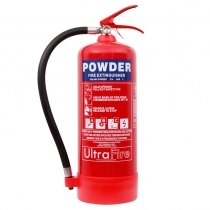 |
Blue |
| Best For |
| Can be used on fires involving organic solids, liquids such as grease, fats, oil, paint, petrol, etc but not on chip or fat pan fires. Can also be used on gas fires. |
| Danger |
Safe on live electrical equipment, although does not penetrate the spaces in equipment easily and the fire may re-ignite. This type of extinguisher does not cool the fire very well and care should be taken that the fire does not flare up again.
Smouldering material in deep seated fires such as upholstery or bedding can cause the fire to start up again. Do not use on domestic chip or fat pan fires. There is also danger of inhalation if powder extinguishers are used within buildings. Due to this, and the potential for powder to impair vision, powder extinguishers are no longer recommended for use within enclosed spaces. |
| How to Use |
| Point the jet or discharge horn at the base of the flames and, with a rapid sweeping motion, drive the fire towards the far edge until all the flames are out. If the extinguisher has a hand control, wait until the air clears and if you can still see the flames, attack the fire again. |
| How it Works |
| Similarly to almost all extinguishing agents the powder acts as a thermal ballast making the flames too cool for the chemical reactions to continue. Some powders also provide a minor chemical inhibition, although this effect is relatively weak. These powders thus provide rapid knockdown of flame fronts, but may not keep the fire suppressed. |
Dry Powder Extinguisher (Special Powders)
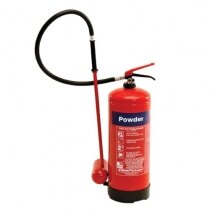 |
Blue |
| Best For |
| These specialist powder extinguishers are designed to tackle fires involving combustible metals such as lithium, magnesium, sodium or aluminium when in the form of swarf or powder.
There are three special powders based on graphite, copper and sodium chloride. |
| Danger |
| Do not allow water to come in contact with the burning metal and the powder must be gently applied. Sodium Chloride is not recommended for Lithium. |
| How to Use |
| The lance enables the user to tackle fires at a safe distance. The low velocity applicator reduces the energy of the jet allowing the powder to gently smother the surface of the burning material thus avoiding scattering the high temperature particles and stimulating the formation of a crust. The method of application is completely different from a standard extinguisher and user training is required. They are not suitable for use on live electrical fires. |
| How it Works |
| This extinguisher works by forming a crust which insulates the metal to prevent access to other combustible material nearby and smothering the fire to prevent oxygen from the atmosphere reacting with the metal |
Foam Extinguisher (AFFF)
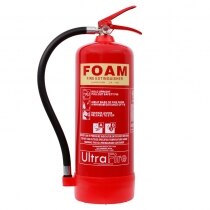 |
Cream |
| Best For |
| Fires involving solids and burning liquids, such as paint and petrol but not suitable for chip or fat pan fires. Safe on fires caused by electricity if tested to 35kV (dielectric test) and a 1m safety distance is adhered to. |
| Danger |
| Do not use on chip or fat pan fires. |
| How to Use |
| For fires involving solids, point the jet at the base of the flames and keep it moving across the area of the fire. Ensure that all areas of the fire are out. For fires involving liquids, do not aim the jet straight into the liquid. Where the liquid on fire is in a container, point the jet at the inside edge of the container or on a nearby surface above the burning liquid. Allow the foam to build up and flow across the liquid. |
| How it Works |
| They are mainly water based, with a foaming agent so that the foam can float on top of the burning liquid and break the interaction between the flames and the fuel surface. |
Carbon Dioxide Extinguisher
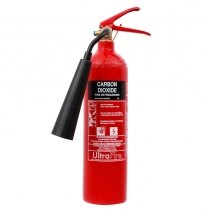 |
Black |
| Best For |
| Live electrical equipment, although it allows re-ignition of hot plastics. Now mainly used on computer servers, although care has to be taken in small server rooms as CO2 gas is poisonous at 4% and can kill at just 8% concentration. |
| Danger |
| Do not use on chip or fat pan fires, as it can carry burning fat out of the container. This type of extinguisher does not cool the fire very well and you need to ensure that the fire does not start up again. Fumes from CO2 extinguishers can asphyxiate if used in confined spaces: ventilate the area as soon as the fire has been controlled. Only use CO2 extinguishers with frost-free horns, as the hand holding the horn can otherwise be frozen to the horn, as the gas gets very cold during the discharge. A relatively small increase in CO2 levels can overcome and potentially kill a user. |
| How to Use |
| The discharge horn should be directed at the base of the flames and the jet kept moving across the area of the fire. Note: CO2 extinguishers only provide 6 to 10 seconds of fire fighting. |
| How it Works |
| Carbon dioxide extinguishers work by suffocating the fire. Carbon dioxide displaces oxygen in the air. However, once discharged, the CO2 will dissipate quickly and allow access for oxygen again, which can re-ignite the fire. |
Wet Chemical Extinguisher
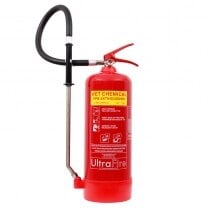 |
Canary Yellow |
| Best For |
| Wet chemical fire extinguishers are ideal for Class F fires, involving cooking oils and fats, such as lard, olive oil, sunflower oil, maize oil and butter. |
| Danger |
| Check manufacturer’s instructions for suitability of use. These extinguishers are usually not recommended for class B fires such as petrol, although Gloria has produced a 3 ltr wet chemical extinguisher with B rating. |
| How to Use |
| Apply the wet chemical using the extended applicator in slow circular movements, which gives a gentle, yet highly effective application. Apply the fine spray onto the burning fat until the surface of the burning cooking oil changes into a soapy like substance which prevents re-ignition. The gentle application helps to prevent burning oil splashing out of the container. Make sure that you empty the entire content of the wet chemical extinguisher onto the oil/fat, as the fire can re-ignite otherwise. |
| How it Works |
| Most class F extinguishers contain a solution of potassium acetate, sometimes with some potassium citrate or potassium bicarbonate. The extinguishers spray the agent out as a fine mist. The mist acts to cool the flame front, while the potassium salts saponify the surface of the burning cooking oil, producing a layer of foam over the surface. This solution thus provides a similar blanketing effect to a foam extinguisher, but with a greater cooling effect. The saponification only works on animal fats and vegetable oils, so most class F extinguishers cannot be used for class B fires. The misting also helps to prevent splashing the blazing oil.
Tests have established that a 6 litre wet chemical fire extinguisher with a 75F rating can deal with a fat fire of maximum 0.11 m2 surface area. |
Fire Blanket
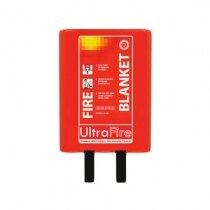 |
Fire blankets are made of fire resistant materials. They are useful for smothering small pan fires or for wrapping round a person whose clothing is on fire. Fire blankets conforming to British Standard BS EN 1869 : 1997 are suitable for use in the home. BS 7944 : 1999 is the specification for specialist heavy duty industrial use. Fire blankets should generally be disposed of after use. |
| Best For |
| Small pan fires where oil or fat has caught fire and clothing fires. |
| Danger |
| If the blanket does not completely cover the fire, it will not be able to extinguish the fire.
While kitemarked fire blankets have been successfully tested on deep fat fryers, modern frying fats are difficult to extinguish with a fire blanket. We therefore recommend wet chemicals for deep fat fryers. |
| How to Use |
| Place carefully over the fire. Keep your hands shielded from the fire. Do not waft the fire towards you. |
| How it Works |
| Smothers the fire and prevents oxygen getting to the fire. |
Hose Reel
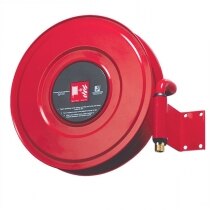 |
Best for |
| Fires involving organic solid materials such as wood, cloth, paper, plastics, coal etc. |
|
| Danger |
| Do not use on burning fat or oil or on electrical appliances before the electric supply has been isolated. |
| How to Use |
| Point the jet at the base of the flames and keep it moving across the area of the fire. Ensure that all areas of the fire are out. |
| How it Works |
| Water has a great effect on cooling the fuel surfaces and thereby reducing the pyrolysis rate of the fuel. |
Fire Buckets
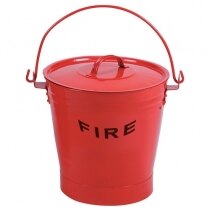 |
A simple bucket of water can be used on Class A type of fires either to supplement a water extinguisher or as a first attack if an extinguisher is not immediately available. It also can be filled with dry sand and used as an absorbing agent or to dam a flow of flammable liquid. They do have serious disadvantages as they are often misused, left empty or allowed to be used as a refuse container. |
| Best For |
| Wood, Cloth, Paper, Plastics, Coal (if filled with water). Spilled flammable liquids (if filled with sand) |
| Danger |
| Do not use on burning fat or oil or on electrical appliances before the electric supply has been isolated. |
| How to Use |
| Throw at the base of the flames. Ensure that all areas of the fire are out. |
| How it Works |
| Water has a great effect on cooling the fuel surfaces and thereby reducing the pyrolysis rate of the fuel. |
Tags:extinguisher types fire extinguisher portable extinguishers
Categories:Fire Safety Equipment
March 15, 2011[Last updated: December 14, 2022]











Comments are closed here.